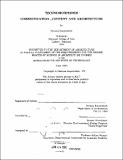Technomorphosis : communication, content and architecture
Author(s)
Inayatullah, Imrana
DownloadFull printable version (47.90Mb)
Other Contributors
Massachusetts Institute of Technology. Dept. of Architecture.
Advisor
Dennis Frenchman.
Terms of use
Metadata
Show full item recordAbstract
To interpret the meaning of the built environment which surrounds us today, we must confront a plurality of architectural movements, each with its own built-in value system, iconographic references and select languages. The notion of a modern or 'contemporary' mode of expression has been made obsolete. We are faced instead with parallel, competing schools of thought, often contradictory in intention and outcome. It is my hypothesis that it is possible to isolate an undercurrent in architectural theory and design, which I call "Technomorphosis", that explains the crucial aspects of our present condition. It is my belief that the basis for Technomorphosis, is not rooted in recent history, but rather, can be traced back to speculative, avant-garde and revolutionary movements emerging during the period of the Industrial Revolution and the years immediately following it. To uncover the nature and limits of this undercurrent, I have studied three parallel scales of environment in which this development is taking place: -- The building, as an object with a distinct meaning. -- Open Space, as the bridge between groups o{ buildings, -- and the means of clarifying their relationships. The City, as a complex entity which deals with the relationship of objects and spaces on a comprehensive scale. Essentially, these investigations have led me to three propositions, which become central to the idea of Technomorphosis. These can be summarized as follows: -- A new meaning and expression has emerged in contemporary architecture which no longer relies on the traditional static relationship between the understanding of an idea and its visual image. Instead, there is an evolving mode of expression which is essentially dynamic and fragmentary, it embodies an interactive relationship between viewer and object. -- This new current of architectural expression actually looks back to utopic ideas emerging in the l ate 19th and early 20th centuries, there exists a 'time-lag' between idea and its physical manifestation in the built environment. -- This particular current is on the leading edge of a fundamental metamorphosis now taking place in the nature of the built environment. It is based on the increasing impact and dominance of technology and the information revolution in which communication and content become the basis for form. It is my belief that these propositions reveal the essential forces behind the environmental metamorphosis taking place today, an "architectural technomorphosis".
Description
Thesis (M.S.)--Massachusetts Institute of Technology, Dept. of Architecture, 1986. MICROFICHE COPY AVAILABLE IN ARCHIVES AND ROTCH Includes bibliographical references (p. 291-296).
Date issued
1986Department
Massachusetts Institute of Technology. Department of ArchitecturePublisher
Massachusetts Institute of Technology
Keywords
Architecture.